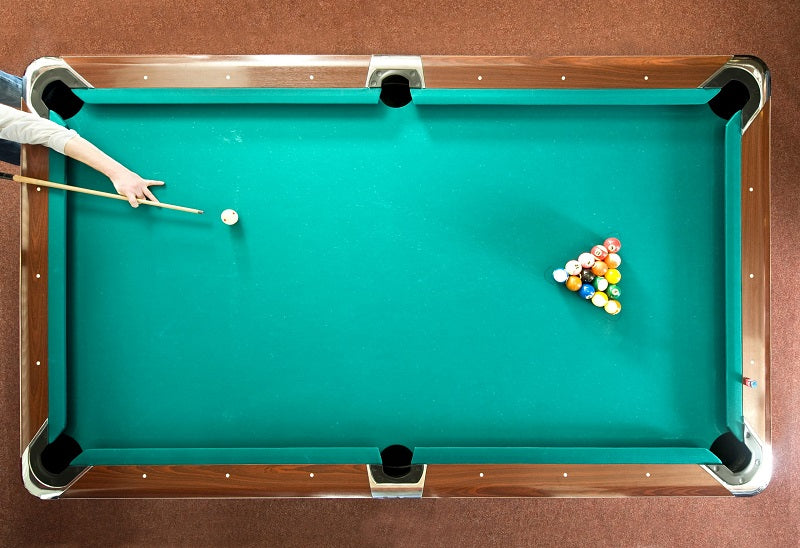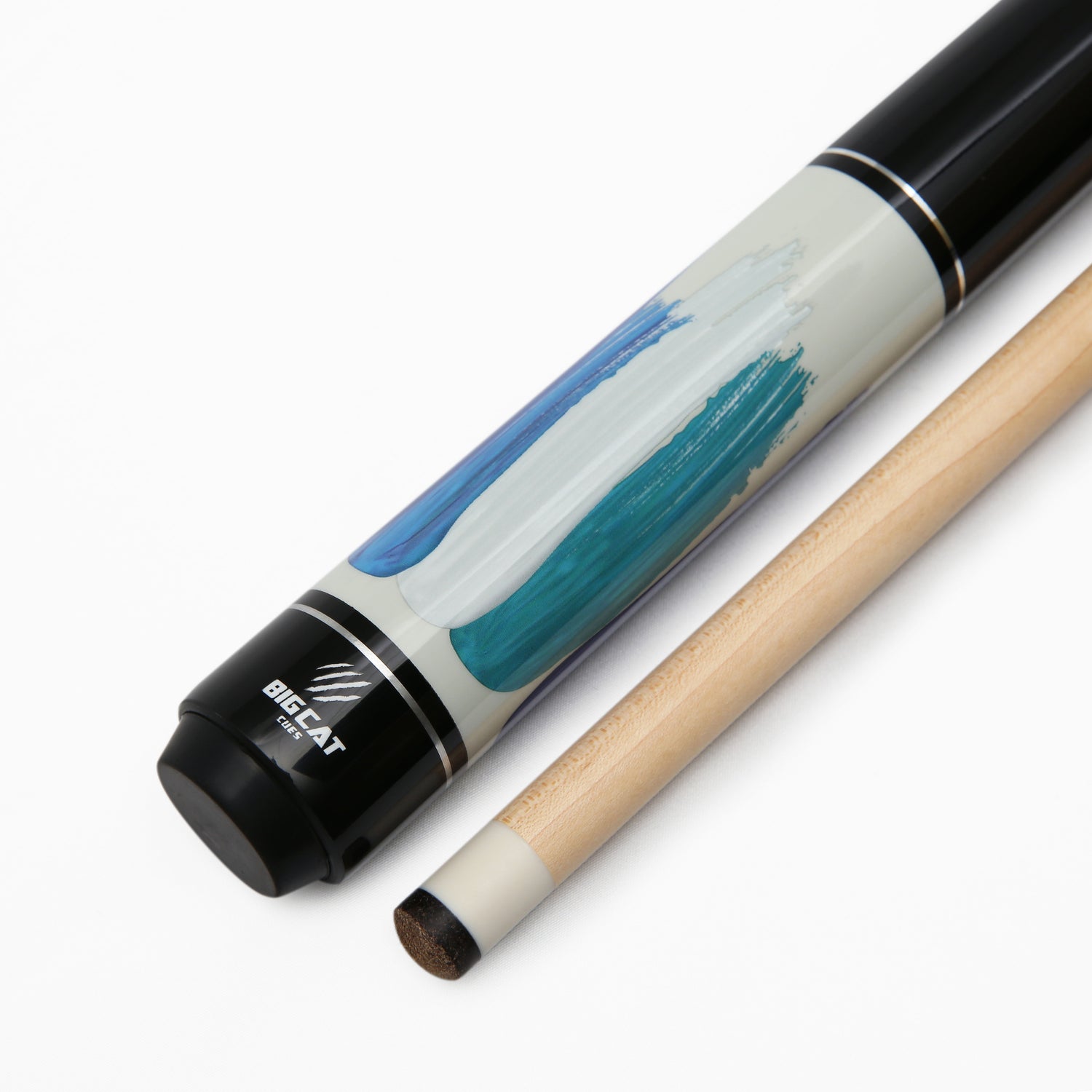
How to Break in Pool in 3 Steps? 10 Pro Tips You May Not Know
Breaking a rack plays a vital role in billiards as it can set the tone for the game. It appears simple, but it is hard to master because many factors must be controlled, such as ball position, hand position, body position, targeting, etc…
You might wonder if there’s a best way to break in pool, this article will help you answer this question. Learn how to break in pool and get some helpful pool break tips for beginners from Big Cat.
3 Steps to Break a Rack in Pool
A successful break is the first step to a good game in billiards. Below are 3 steps you should take when breaking in pool.
Step 1: Getting Into A Position
1. Rack The Ball
Gather the balls and place them in the rack. Put the base of the rack parallel to the back of the pool table. Then, place the eight ball in the rack center.

Image via SVET
Set a solid ball in one corner and a striped one in the other. Finally, push the balls together so that all balls are in contact, leaving no gaps between balls. Knowing how to rack the balls is crucial because players will break more consistently when the pool balls are tightly racked.
2. Place The Cue Ball On or Behind The Head StringPlace the Cue ball anywhere on or behind the head string, in the quarter section of the pool table furthest away from the rack.
Pool players should not set the ball in the middle of the head string, opposite the head ball. This is because the pool table will be more worn down in this area. Therefore, you may not have an excellent shot. Instead, you can put the ball slightly off to one side so your break shot is slightly angled..
3. Stand Behind The Cue Ball.You should move forward from the waist and bend your knees slightly. Be sure to have a good grip and bridge (explained in step 4) on the pool cue, using both hands and executing the cue toward the cue ball.
Also, find a suitable hip width. A wider space will give you more stability. Conversely, a narrow one will provide more speed when you move your hips forward through the shot.
4. Place Your Hand On The Table On A Closed Bridge.Put your hand on the table, and then apply the pool cue across the middle of your thumb and index finger. Bend your index finger around the cue.
After that, touch it with your thumb to draw a circle around the shaft. Lay your fingers for more stability. You should relax your bridge hand to ensure accuracy. A closed bridge will prevent your pool cue tip from rising.

Image via Pearson Cues
In this step, having a pool stick from Paint Brush Line - Big Cat will be a significant advantage for you. Crafted meticulously from Grade A Canadian Maple, this solid shaft promises consistent, smooth strokes. Moreover, measuring at a standard 58", this cue is designed for all-level players with a perfect balance and comfortable grip.
5. Define The Distance Between Your Bridge Hand And The Ball.Some pool players like a longer bridge distance. For instance, they set up their bridge hand 8 or 10 inches from the ball. This position will create more force for the beak.

Image via World of Pool and Billiards
However, you may only get accuracy when your bridge distance is close enough. Therefore, try until you find a distance that works well. For example, beginners often place their pool sticks on the back rail.
6. Move Your Back Hand Into Position Behind Your Shoulder.Hold the pool stick firmly with your backhand. Close your fingers around the pool cue. Move them behind your shoulder and above your hip.
- Some prefer a longer backswing because they will have more force.
- Some people like to choke up slightly on the backswing, generating higher accuracy.
Step 2: Aiming
1. Aim Straight At The Head BallHit the center of the head ball, which is at the top of the rack. By switching the center of the head ball, you will efficiently transfer force toward the rest of the rack and adequately distribute the balls.

Image via PoolDawg
By achieving this, the balls scatter across the pool table, increasing the likelihood of a favorable layout post-break. This fundamental technique in pool can set the tone for the entire game.
2. Line Up Your Cue And Focus Your AttentionHit the cue ball ½" (13 millimeters) below the center, the size of the tip of your pool cue. Switching it just below the center lets you stop the cue ball in the middle of the table.
Glancing back and forth between the cue and head ball. Once comfortable with the shot, direct your focus to the head or ball. Keep your eyes on the ball before shooting.
3. Notice The Object Paths In A BreakAdjust your aim slightly based on the object paths involved in your break. If you play 8 balls, you can shoot the two balls behind the head ball into the side pockets.
If you play 9 balls, you could get wing balls in the back pockets. Define your aim until you can sink some of these balls more reliably.
Step 3: Shooting
1. Pull Your Cue Back Slowly With Your BackhandBring your backhand behind your shoulder and just above your hips. You can bring it back further if you want more of a backswing.

Image via Pearson Cues
You want a smooth, controlled backswing with complete follow-through. A steady, square influence creates more force than a lightning-fast shank.
2. Contact The Head DirectlyHit the head ball directly on target to break the rack effectively. You must also apply enough pressure to move the balls around the table. The tip is to focus on a square hit instead of trying to use more force.
Hitting the head ball squarely is essential. The force in the break shot is from the legs and hips. Therefore, let's move your hips forward to achieve greater force.
3. Shoot The Cue Ball.You must use the cue stick to hit the cue ball. Bend your body forward from the hips to create more power. In this case, you should use a high-quality pool cue with great balance and power.
Equipped with the Big Cat Professional Leather Tip, this Timeless Legacy Cues at Big Cat assures exceptional contact with the ball, allowing for accurate spins and powerful breaks.

Image via PoolDawg
Then, let your torso move up at the end of the stroke. Your pool cue should be pointing toward the back of the table after shooting.
4. Fine-tune Your Break Shot.Take a moment after each shot to notice the cue ball's position. If the cue ball moves forward, hit it lower for more backspin. However, shoot it slower if it moves toward the sides for higher accuracy and power.
That’s 3 steps on how to break in pool. Remember, a good break can set you up for a successful game. Therefore, it's worth investing time in practicing and mastering this skill.
10 Pro Tips to Break in Pool Like a Pro
Tip 1: Sharpen Your Stance
Experts recommend adjusting your stance for a stronger break stroke when playing billiards. Bring your feet closer together to create a narrower stance than usual. This position is beneficial when you want to force your hips and torso forward more during the break. Below is the reference of grip position:

Image via Pearson Cues
Most professional players prefer placing their front foot ahead during this shot. Additionally, standing a bit straighter than you would for a regular shot is advised. However, keeping a slight bend in your legs is still essential. This position helps you build momentum, making your break stroke stronger and more effective.
Tip 2: Be Flexible
Achieving a successful break shot in the pool often requires flexibility. Being adaptable in your strategy is critical. This might involve changing the cue ball's position or adjusting the speed before you strike.
Adapting your break strategy, including considering softer breaks, can be a more innovative approach to sinking a ball.
Tip 3 Understand Pool Rules
Understanding pool rules can be daunting initially, but it's straightforward once you break it down! Here are some basic essential rules for the most popular pool game, 8 ball, based on the American Poolplayer Association:
Gameplay
- Break shot: The first player breaks the balls by hitting the cue ball towards the triangle. At least one ball (including the cue ball) must hit a cushion, and at least one object ball must be pocketed for the break.
- Choosing sides: After the break, the player who legally pockets a ball first calls solids or stripes.
- Taking turns: Players shoot, trying to pocket their designated balls without committing any fouls.
- Scratching: If you pocket the cue ball, it's a scratch, and your opponent can place it anywhere on the table.
- Pocketing the 8-ball: You can only legally pocket the 8-ball after pocketing all your designated balls. You lose the game if you lift the 8-ball prematurely or commit a foul.
Basic Fouls
- Scratching
- Pocketing the cue ball in addition to another ball
- Hitting the cue ball off the table
- Not hitting your designated balls first
- Touching a ball with your hand or clothing while the cue ball is in motion
- Double-hitting the cue ball (hitting it twice in one stroke)
The first player to legally pocket all their designated balls, and then the 8-ball wins the game!
Tip 4: Choose Your Spot Wisely.
Choosing your spot wisely in the pool involves strategic thinking, skillful execution, and a good understanding of the game. Here are some essential tips to help you make intelligent positioning and shot selection decisions:
- Always think at least two to three shots ahead. This foresight allows you to position the cue ball in the best possible spot for subsequent shots, not just the immediate one.
- Learn how the cue ball reacts to different strokes, spins (English), and angles. This knowledge is crucial for putting the ball after each shot.
- Work on drills that focus on cue ball control. This will improve your ability to place the cue ball in a desired spot.
- Before each shot, evaluate the table layout. Identify potential problem balls (balls that are hard to pocket or access) and plan your run-out (sequence of shots) accordingly.

Image via Wiki How
Tip 5: Use A Closed Bridge.
Using a closed bridge in the pool is a technique that can enhance your accuracy and stability when shooting. A closed bridge provides a more stable platform for the cue stick to slide through. This stability is essential for precise shots and controlling the speed and spin of the cue ball. You can see how to set up your fingers as follows:

Image via Basic Billiards
Below are 4 steps on how to form a closed bridge:
- Hand position: Flatly on the table with your fingers spread out. The hand should be stable and comfortable.
- Forming the bridge: Bring your thumb towards your index finger, forming a loop. The size of this loop is different based on your preference and the size of your hand.
- Position of the Cue: Slide the cue through the loop created by your thumb and index finger. The cue should rest on your middle finger, which guides you.
- Adjusting the Bridge: You can change the bridge's height by arching your hand more or less, depending on the shot you're taking and the angle required.
Tip 6: Mind Your Bridge Distance.
The distance between your bridge hand (stabilizing the cue) and the cue ball greatly influences your shot accuracy. If it is too close, you might not have enough space to accelerate the cue for the desired speed. Conversely, your cue might wobble if it is too far, reducing precision.
Colorado State University says the bridge length should match the stroke length. This provides a balance between control and power for most shots.
- For power shots (like a break shot), you might extend your bridge to 12 inches (30 cm) or more to allow a longer stroke.
- A shorter bridge of about 6-8 inches (15-20 cm) might provide better control for delicate, precise shots.
Tip 7: Find Your Perfect Backhand Position.
The backhand position refers to the placement of your grip hand on the cue stick, which can significantly influence your control and power. Here are 2 steps to help you find your ideal backhand position:
- As a starting point, place your backhand near the end of the cue butt. This position offers a good balance between control and power.
- For power shots like the break, you should move your hand slightly toward the end of the cue for more leverage and force.
- For finesse shots, moving your grip slightly forward can provide better control.

Image via Pearson Cues
Tip 8: Strike The Cue Ball In The Center.
The best way to break in pool is by hitting the center of the cue ball, which minimizes unintended spin (English). Striking the center also reduces the chances of miscues (when the cue tip slips off the ball) and helps maintain a straight shot line. Below is the example cue ball center:

Image via Sharivari
Align your cue stick directly with this point. Some players visualize a small dot or mark at the center to help with alignment. Then, Ensure your stance and cueing action are stable and aligned. A straight, consistent stroke is critical to hitting the center.
Tip 9: Keep your eye on the ball.
Focusing on the ball helps in aligning your shot correctly. When your eyes are locked on the target (cue ball or the object ball), it increases the likelihood of hitting the ball precisely where you intend.

Image via Freepik
Moreover, consistently focusing on the ball and seeing positive results builds your confidence, which is crucial for taking on more challenging shots and opponents.
Tip 10: Focus On Accuracy, Not Power
Another best way to break in pool is to focus on accuracy. It lets you precisely control the cue ball's speed and direction. This control is critical to setting up your next shot and making strategic plays.
Power shots can be less consistent than accurate ones. Shooting the ball too hard can lead to losing control and increase the chances of missing your target. Consistency in your stroke and shot selection often leads to better overall performance.
In complex situations where you need to navigate around obstacles or execute trick shots, accuracy is far more important than power. Precise shots can help you escape tough spots or sink difficult balls.
To sum up, breaking in billiards is an important stage of the whole game. A successful break can scatter the balls effectively, opening up scoring opportunities and potentially putting your opponent in a difficult position.
If Pool playing is your passion, start to learn how to break in pool and experiment to find your unique approach to accomplish the finest shot. The best way to break in pool typically involves a combination of technique, positioning, and power. Therefore, practice everything to be a better pool player.
See more: Pool bank shots


